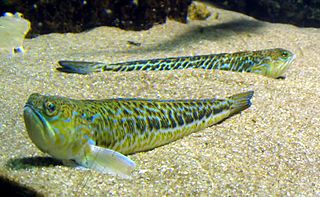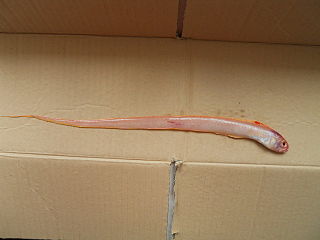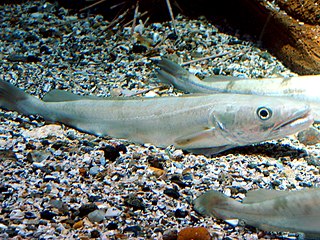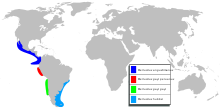The term hake refers to fish in the:

The Merlucciidae, commonly called merluccid hakes, are a family of cod-like fish, including most hakes. They are native to cold water in the Atlantic and Pacific Oceans, and typically are found at depths greater than 50 m (160 ft) in subtropical, temperate, sub-Arctic or sub-Antarctic regions.

The North Pacific hake, Pacific hake, Pacific whiting, or jack salmon is a ray-finned fish in the genus Merluccius, found in the northeast Pacific Ocean from northern Vancouver Island to the northern part of the Gulf of California. It is a silver-gray fish with black speckling, growing to a length of 90 cm (3 ft). It is a migratory offshore fish and undergoes a daily vertical migration from the surface to the seabed at depths down to about 1,000 m (3,300 ft). It is the object of an important commercial fishery off the West Coast of the United States, and annual quotas are used to prevent overfishing.

The silver hake, Atlantic hake, or New England hake is a merluccid hake of the genus Merluccius, found in the northwest Atlantic Ocean. It is highly predatory and typically feeds on fish and crustaceans.
Sepia australis, the southern cuttlefish, is a species of cuttlefish which is found in the eastern South Atlantic Ocean and the western Indian Ocean off the coasts of Southern Africa, possibly extending into the waters off East Africa.

Trachinus is a genus of weevers, order Perciformes that consists of seven extant species. Six of the genus representatives inhabit the waters of Eastern Atlantic Ocean, but only one, Trachinus cornutus, inhabits the South-Eastern Pacific Ocean. Three of the Atlantic species occur near the coasts of Europe. An eighth extinct species, T. minutus, is known from Oligocene-aged strata from the Carpathian Mountains, while a ninth species, also extinct, T. dracunculus, is known from middle-Miocene-aged strata from Piemonte, Italy.

Cepola is a genus of marine ray-finned fishes belonging to the bandfish family, Cepolidae. The name red bandfish is applied to all members of this genus, but particularly C. macrophthalma, and generally not C. australis, which is also known as the Australian bandfish.

Lepidotrigla is a genus of marine ray-finned fishes belonging to the family Triglidae, the gurnards and sea robins. These gurnards are found in the Eastern Atlantic, Indian and Western Pacific Oceans.

Merluccius merluccius, the European hake, is a merluccid hake of the genus Merluccius. Other vernacular names include Cornish salmon and herring hake. It is a predatory species which was often netted alongside one of its favoured prey, the Atlantic herring, thus the latter common name. It is found in the eastern Atlantic from the Norway and Iceland south to Mauritania and into the Mediterranean Sea. It is an important species in European fisheries and is heavily exploited with some populations thought to be being fished unsustainably.

Merluccius gayi is a merluccid hake of the genus Merluccius, with two subspecies, the South Pacific hake or Chilean common hake and the Peruvian hake, found in the south-western Pacific Ocean, along the coast of South America, from Peru to the Chilean coasts north to the Chiloé Archipelago. During the Southern Hemisphere summer, it migrates southwards in shallow waters, while in the winter, it lives more to the north, in far deeper waters.

Merluccius capensis is a ray-finned fish in the genus Merluccius, found in the south-eastern Atlantic Ocean, along the coast of South Africa. It is a long, lean fish with a large head, similar in appearance to the European hake and the deep-water Cape hake. By day, it lives close to the bottom on the continental shelf and upper slope at depths not usually exceeding 400 m (1,300 ft); it makes a large, daily vertical migration rising at night to feed in the nectonic zone, and it also migrates southwards in spring and northwards in autumn. It is an important commercial fish species in southern Africa.

The Argentine hake is a merluccid hake of the genus Merluccius, found in the southwestern Atlantic Ocean, along the coast of Argentina, and Uruguay. This fish was described by an Argentine ichthyologist, Tomás Marini in 1933.
Merluccius paradoxus, the deep-water Cape hake, is a merluccid hake of the genus Merluccius, found in the south-eastern Atlantic Ocean, along the coast of Southern Africa, south of Angola. Its range extends in decreasing abundance around the southern coast of Africa and into the Indian Ocean, but it is at its most plentiful in the cold, nutrient-rich fishing grounds of the Benguela Current.
The Panama hake, also known as the dwarf hake, is a merluccid hake found off the west coast of the Americas from Del Mar, California, to Ensenada de Tumaco, Colombia.

Scorpis is a genus of marine ray-finned fish from the subfamily Scorpidinae of the sea chub family Kyphosidae which are native to the eastern Indian Ocean and the Pacific Ocean.
Merluccius australis, the southern hake, is a species of fish from the family Merlucciidae, the true hakes. It is found in the southern Pacific and Atlantic Oceans with two disjunct populations, one around southern South America and the other in the waters around New Zealand.
Merluccius patagonicus, the Patagonian hake, is a species of fish from the family Merlucciidae from the western South Atlantic which was described in 2003. However some authorities consider the distinguishing features of M. patagonicus to be within the range of variability for M. hubbsi and that M. patagonicus is therefore a synonym of M. hubbsi.
Merluccius polli, the Benguela hake, is a species of fish from the family Merlucciidae, the true hakes. It is found in the tropical waters of the eastern Atlantic Ocean off the west coast of Africa.
Merluccius senegalensis, the Senegalese hake, is a species of fish from the family Merlucciidae, the true hakes. It is found in the sub tropical waters of the eastern Atlantic Ocean off the north western coast of Africa.
Merluccius tasmanicus is a species of fish from the family Merlucciidae from the western Pacific and south-eastern Pacific and south-western Atlantic which was described in 2006. It is however considered to be synonymous with Merluccius australis by some authorities.











